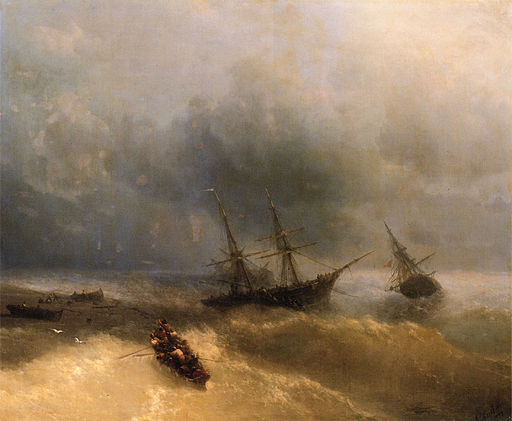The Shipwreck by Ivan Aivazovsky [Public domain], via Wikimedia Commons
Given the dangers of travel by sea in the 18th century it has always amazed me how frequently people crossed the Atlantic. Sea captains like Stephen Blankett made regular trips to Jamaica every year, and it was on ships such as his that hopefuls travelled out looking to make their fortune, and colonists travelled home. Britons sent their Jamaican born children “back home” to be educated, to enter mainstream society, and to marry. Many fled the heat and disease hoping to make a full recovery in the cooler climate of England. Not everyone made it.
On the 25th of July 1782 a fleet left Bluefields Bay Jamaica for England, it included the Ville-de-Paris, which had been the flagship of the Comte de Grasse during the American Revolutionary war and had been captured by Admiral Rodney, and on board the British Queen with Captain James Hodge were John Ellis his wife Elizabeth and their niece Anna Maria making her first trip to England.
The British Queen was a ship of 350 tons with a crew of 45 and 20 carriage guns, which in 1761 had been owned by “Peter Impaud, Elias Benjamin de la Fontain, Daniel Vialars and others of London, merchants” when she was issued with letters of marque against the French. In May 1776 she had been included in a fleet of transports taking troops and wagons to Canada, and another record refers to her making a trip to Greenland. In 1777 she had been surveyed at Deptford and found fit for service as a transport ship. In 1780 her then owners, Wilkinson and Company, offered her to the government to carry stores to Jamaica and it is possible she was returning with the fleet from this latest episode in July 1782.
John Ellis had married Elizabeth Palmer in 1754. They had two sons John and Charles Rose who were already in England. Ellis was one of the largest landowners in Jamaica, son of George Ellis and Anne Beckford he had inherited the Newry plantation in St Mary, half of the Sixteen Mile Walk plantation and a share in Palm plantation in St Thomas in the Vale. In 1752 he bought Montpelier from the widow of Francis Sadler Hals. When his brother George died in 1753 leaving a pregnant wife, he acquired about another £30,000 of property on the grounds that his brother’s Will had failed to make provision for any possible children.
In the days before weather forecasts and mass communications ships captains relied on a combination of luck and experience when it came to avoiding extremes of weather. By 1782 it was well understood that there was a hurricane season in the Caribbean, but there was no way of predicting when or where specific storms would strike. The route frequently taken by ships sailing back to England was heading north out of the Caribbean and up the coast of America before striking out across the Atlantic.
It seems that the fleet had got roughly to the latitude of Boston when in the early hours of the morning of the 17th of September the storm hit them. Initial reports in the British press during October and November concentrated mainly on the fate of the Ville-de-Paris.
A Captain Cox who arrived in London in early December reported having seen the ship after the storm and that she had lost her main and mizzen masts and that the crew had thrown all the guns overboard and sealed up the gun ports. The ship had been pooped, that is hit by a huge wave on her stern which had carried away a large part of the structure, however the crew had used sail canvas to seal the ship and when last seen by Captain Cox she had been heading for the Azores under jury rig. However a report in the Leeds Intelligencer on 24 December 1782 said that “the Sylph cutter, which sailed to the Western Islands near two months ago to look after the Ville-de-Paris and the Glorieux men of war is returned to Spithead, without having obtained any intelligence of them.”
News of the ill-fated Ellis family was finally reported in the Hereford Journal on the 9th of January 1783.
“William Shotton, late servant to John Ellis, Esq of St Mary’s, Jamaica, who took his passage from that island, in the month of July last, for London, on board the British Queen, Captain Hodge relates the following melancholy tale: That they sailed from Jamaica on the 15th of July, under convoy of the Ramillies ; that his said Master, together with his wife and two nieces, two boys his wards, and four servants were on board; that they met with nothing particular on the passage till the 17th of September, when at three o’clock in the morning in lat.42 there came on a violent gale of wind, accompanied by a swelling sea which strained the ship almost to a wreck, and caused her to make so much water, that the pumps were obliged to be kept incessantly going. At three o’clock in the afternoon it laid the ship on her beam ends, and carried away her mizzen mast, with various other things, off the deck, and at the same instant washed the said William Shotton overboard, and likewise his wife, who then happened to have fast hold of his clothes; but having both got hold of the wreck and entangled themselves with the ropes, they floated in this situation for near two days, and were then providentially taken up by the ship Catherine, Captain McLey, bound from Cork to New York. They were afterwards taken by an American priveteer, and carried to the Havannah, from whence they obtained a passage to Philadelphia, and from that place to New York, where he embarked on board the Minerva Captain McAddams, which is arrived at Portsmouth. Whilst they remained on the wreck, he frequently saw the ship on her beam ends: but being much exhausted and struck with heavy seas, the ship disappeared to him, so that he cannot say for certain whether she righted or sank, but is inclined to believe from her distressed state, and having six feet water in her hold, she must have inevitably sunk. He could not learn any thing of her from the Catherine‘s people after he was recovered. He further adds, that he saw several ships founder during the gale, but could not learn their names.”
The Wreck of the Assurance
It would seem horribly unlucky that ships which had safely crossed the Atlantic avoiding such storms, and possible capture by an enemy, should end up being wrecked within sight of home. But this is what happened to the naval frigate HMS Assurance which was stranded off the Needles on 24 April, 1753 and which was carrying Edward Trelawney the former Governor of Jamaica. Trelawny had been Governor from April 1738 to September 1752. It was under him that peace had finally been achieved with the Maroons, and his term as Governor was one of the longest and most successful of 18th-century Jamaica until failing health brought about his return to England. During his time in Jamaica his tact and natural diplomacy largely brought an end to the squabbles that had characterised the Jamaican Assembly. With his departure this accord sadly came to an end.
Trelawny survived the wreck of the Assurance and arrived back in London four days after the shipwreck. He died at Hungerford Park on 16th January 1754. A Customs report was lodged relating to a small amount of Rum and other goods saved from the wreck.
22 August 1753 In order to your command signified by Mr Freemantle in his letter of 18th inst. we beg leave to Report that the Rum & and other sundry Goods saved out of the Assurance, Man of War, stranded on this Island were first brought by the persons who took them up floating in the sea to the Custom House & delivered to Mr Wilkinson as a perquisite of Admiralty in case they should not be claimed but as there was not then room in our Warehouse to contain them we lodged the said Goods in a Warehouse hired of Mr George Mackenzie at 12/6 per week [1]
It was possible to insure cargo against loss, indeed there was a thriving insurance industry by the middle of the 18th-century, and many of the letters that survive in the correspondence of absentee planters and plantation factors and commission agents relate to the insuring of cargo. However the best that an individual could do when contemplating a transatlantic voyage was to write a Will and say their prayers.
There are many brief Wills in the collections held at the National Archive at Kew that were written by sailors, both in the Navy and merchant service, leaving their few possessions to wife, mother, or close friend. By the end of the 18th-century so common was the practice that printed Will forms were provided, such as the one completed by Robert Kelly of the Alarm in 1798[2] leaving everything to his sister “Sarah Rex of number 6 Armory Lane, Portsmouth in the county of Hampshire”.
Of course sailors in the Royal Navy faced a variety of risks at sea, but everyone who crossed the Atlantic encountered the dangers of tempest, uncharted reefs, ships undermined by ship worm which disintegrated in heavy weather, and the ever present possibility of human error.
Some lucky ones like Trelawney survived shipwreck, many more like the Ellis family were lost at sea.
[1] http://www.customscowes.co.uk/1753-1764.htm
Collector to Board Letters Book 1753 – 1764 National Archives ref:CUST 61/2
[2] National Archives, Kew, ADM/48/51



